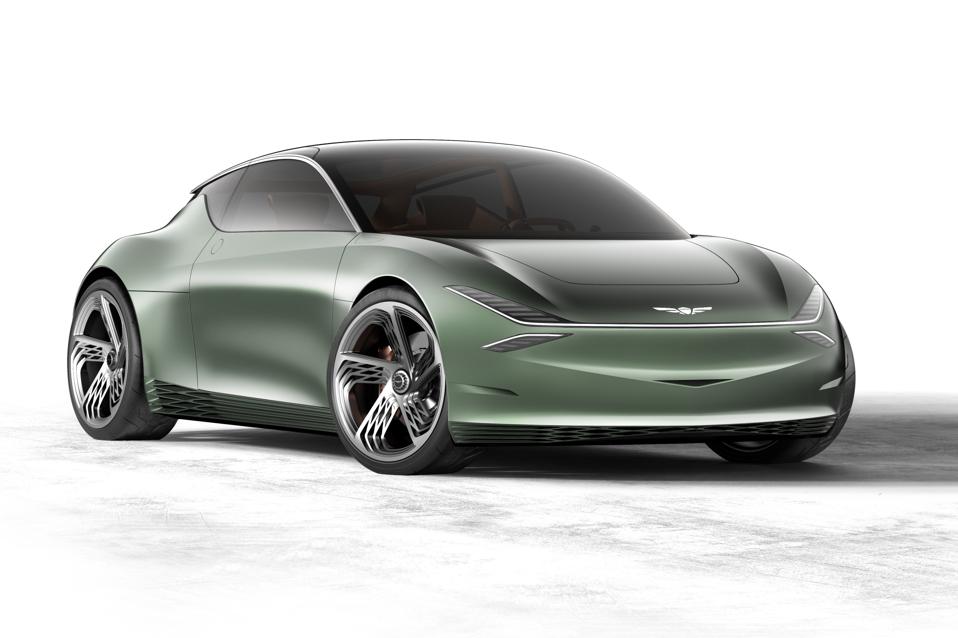Cast your mind back to 2019, with no idea of what was to come, the world was quietly optimistic about entering the 2020s. Before city life as we know it was swiftly dismantled, Genesis unveiled its Mint concept, a two-seater compact luxury model aimed at taking the stress out of city driving. Although it’s not made its way into production, glimpses of the concept have appeared in things like the GV60’s crystal ball feature.
To find out what made the Mint so special and such a step away from the rest of the brand’s lineup, I spoke with Luc Donckerwolke, Chief Creative Officer and President of Hyundai Motor Group.
Trinity Francis: What was the initial brief for the Mint concept?
Luc Donckerwolke: The brief was to demonstrate that luxury is not linked to size. To the contrary. Size imposes limitations. Genesis should make evident that our Son-nim, our honored guests, can be treated to the highest level of refinement, technological advancement and groundbreaking design regardless of size.
Francis: How did you maximize interior space?
Donckerwolke: The flat floor of the electric platform allowed a better distribution of the furniture to optimize ergonomics—in the spirit of Alec Issigonis when he created the original Mini. The interior is structured like a living space, with a sofa and an instrument panel that both rotate around their middle axis to facilitate ingress and egress. There is no big screen, rather circular digital touchscreens surround the steering wheel to allow instinctive commands without losing sight of the road or contact with the steering wheel.
Francis: Can you explain the design process behind the rear reverse-opening scissor doors?
Donckerwolke: The concept was created while observing the illogical approach to accessing a vehicle’s cargo area—the user having to go first to the rear of the vehicle, leaving the sidewalk to deposit his or her shopping bags, and then return to the side to enter the vehicle. A side trunk access through scissor doors that do not intrude on the sidewalk is therefore practical and logical.
Francis: How was technology integrated into the interior design?
Donckerwolke: The vehicle features every function a driver needs, but the displays are unobtrusive. The small gauge cluster sits within the steering wheel itself, further augmenting the perception of space, and the six small readouts—finished in copper to allude to the vehicle’s electric power source—around the steering wheel added a high-end, luxurious aspect to the concept’s interior design.
Francis: Can you explain the interior and exterior colour choices?
Donckerwolke: The matt mint green and cognac leather colorways are a nod towards traditional luxury cars but done in a more modern and fashionable way. The Mint’s diminutive size is already a step away from tradition—most luxury cars are quite a bit larger—but we sought to accentuate the modernity of the concept by playing with more contemporary colors.
Francis: How has it (or not) influenced Genesis production models since and why?
Donckerwolke: Concept cars like the Mint are designed to communicate the design philosophy and the design elements to the audience. The quad lamps that transport the brand’s Two Lines signature and the G-Matrix graphics—first seen on the Essentia concept but also repeated in the interior of the Mint—were carried over into production, as was the parabolic line on the side and the concave section at the rear of the car. At their core, concept and show cars allow us to push the envelope, experiment, and see what is possible. It allowed the design team to escape their comfort zones and devise solutions—such as the rear doors—that are truly fresh and innovative.
Francis: Were there any inspirations that influenced the design? If so, what were these and why were they influential?
Donckerwolke: The Mint concept was one of the first instances where we showcased our Beauty of White Space interior design philosophy. This is derived from a Korean aesthetic, in which design is pared back and minimalistic, accentuating certain details but leaving space between these elements to bring a sense of calmness to the cabin. European furniture also utilizes the concept of minimalism to great effect, emphasizing clean lines to avoid clutter and focus on the essential. Craftsmanship is another aspect that is visible in both cultures; this is represented in high-quality materials such as the cognac leather and gunmetal balustrade.
Francis: What is your favourite element of the design and why?
Donckerwolke: My favorite aspects of the design are its atypical three-box typology and the clean, uncluttered, and genuinely luxurious cabin. We achieved this by looking at what modern city dwellers value in their daily lives and home décor and devised an appealing product that is very much aligned with Genesis’ values as a brand.
Francis: What were the key challenges in this project?
Donckerwolke: Some of the key challenges were to get internals to appreciate that luxury could be found in small packages. That is not typically the case. When luxury buyers look to a vehicle purchase these are often very large vehicles that have a big footprint. Traditionally this conveys status, which is synonymous with luxury. We had to turn that preconceived notion on its head to develop a car that blends classic proportions with modern, minimalist, and luxurious design but that is compact enough to fit in modern day metropolises.
Francis: Are we likely to see any Mint-like concepts or a production Mint from Genesis in the future?
Donckerwolke: Stay tuned.

